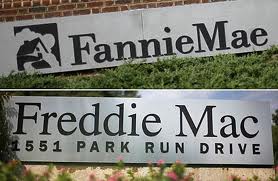It’s the classic tribal warfare. The Republicans wanna blame the Democrats for the boom then bust of the housing bubble. Specifically they wanna blame Carter for the CRA, then Clinton for accelerating it and finally Barney Frank for enabling Fannie Mae and Freddie Mac.
For their part, the Democrats wanna blame the Republicans for easing regulations and over site of the financial markets. Most especially with regards to leveraging, allowing banks to act as investment firms and the existence of the derivative market.
I have long been a believer that it was Fannie and Freddie that drove us up to and then over the cliff. And for a long time have held the Democrats responsible. I am learning and need to amend my position.
It was government policy that drove us up to and then over the cliff. Policy that began with the noble intention of providing affordable housing to more and more people.
However, when government subsidizes, we often always get poor results:
It was perhaps a worthwhile goal, but it caused the financial crisis when it was done by lowering mortgage underwriting standards. In the end, it was a colossal policy error by Congress and two presidential administrations.
Data from the article demonstrates the government’s involvement:
The affordable housing law required Fannie and Freddie to meet government quotas when they bought loans from banks and other mortgage originators.
At first, this quota was 30%; that is, of all the loans they bought, 30% had to be made to people at or below the median income in their communities. HUD, however, was given authority to administer these quotas, and between 1992 and 2007, the quotas were raised from 30% to 50% under Clinton in 2000 and to 55% under Bush in 2007.
…
It is certainly possible to find prime mortgages among borrowers below the median income, but when half or more of the mortgages the GSEs bought had to be made to people below that income level, it was inevitable that underwriting standards had to decline. And they did. By 2000, Fannie was offering no-downpayment loans. By 2002, Fannie and Freddie had bought well over $1 trillion of subprime and other low quality loans. Fannie and Freddie were by far the largest part of this effort, but the FHA, Federal Home Loan Banks, Veterans Administration and other agencies–all under congressional and HUD pressure–followed suit. This continued through the 1990s and 2000s until the housing bubble–created by all this government-backed spending–collapsed in 2007. As a result, in 2008, before the mortgage meltdown that triggered the crisis, there were 27 million subprime and other low quality mortgages in the US financial system. That was half of all mortgages.
In short, the government created the criteria, or the supply, and then the government created the agencies, or the demand.
Of these, over 70% (19.2 million) were on the books of government agencies like Fannie and Freddie, so there is no doubt that the government created the demand for these weak loans; less than 30% (7.8 million) were held or distributed by the banks, which profited from the opportunity created by the government.
So yes, it was the government POLICY that created this bubble. But, back to Fan and Fred, did they have a role?
Of the 19.2 million subprime and low quality loans that were on the books of government agencies in 2008, 12 million (about 62%) were held or guaranteed by Fannie and Freddie.
Yes. And a big one.
However, I’m forced to amend my position. It was not the SOLE fault of Fan and Fred for the crisis, but they are certainly a major player.
 To his credit, and to complete the Liberal tragedy, even Frank himself acknowledges his errors:
To his credit, and to complete the Liberal tragedy, even Frank himself acknowledges his errors:
I hope by next year we’ll have abolished Fannie and Freddie … it was a great mistake to push lower-income people into housing they couldn’t afford and couldn’t really handle once they had it.







